S Plc: Investment Appraisal, CVP Analysis, and Sourcing Strategies
VerifiedAdded on 2023/06/16
|20
|4051
|454
Report
AI Summary
This business report delves into capital investment appraisal for S Plc, a computer games company. It defines the significance of the capital investment appraisal process, drafts a cash flow analysis statement, identifies the payback period for a new investment, and assesses the viability using the net present value (NPV) approach. The report also describes the logic behind the NPV method and its association with the cost of capital, assesses the internal rate of return (IRR), and states reasons why NPV is considered a better approach than IRR. Furthermore, it critically evaluates equity issues versus bank loans for long-term finance, presents a cost-volume-profit (CVP) analysis, and examines the consequences of price level changes on CVP analysis. Finally, the report distinguishes categories of suppliers, compares single and multiple sourcing benefits, and explains cross-sourcing and its benefits to the buyer, providing a comprehensive overview of financial and strategic considerations for S Plc. Desklib provides a platform to access similar solved assignments.

Business Report
Paraphrase This Document
Need a fresh take? Get an instant paraphrase of this document with our AI Paraphraser
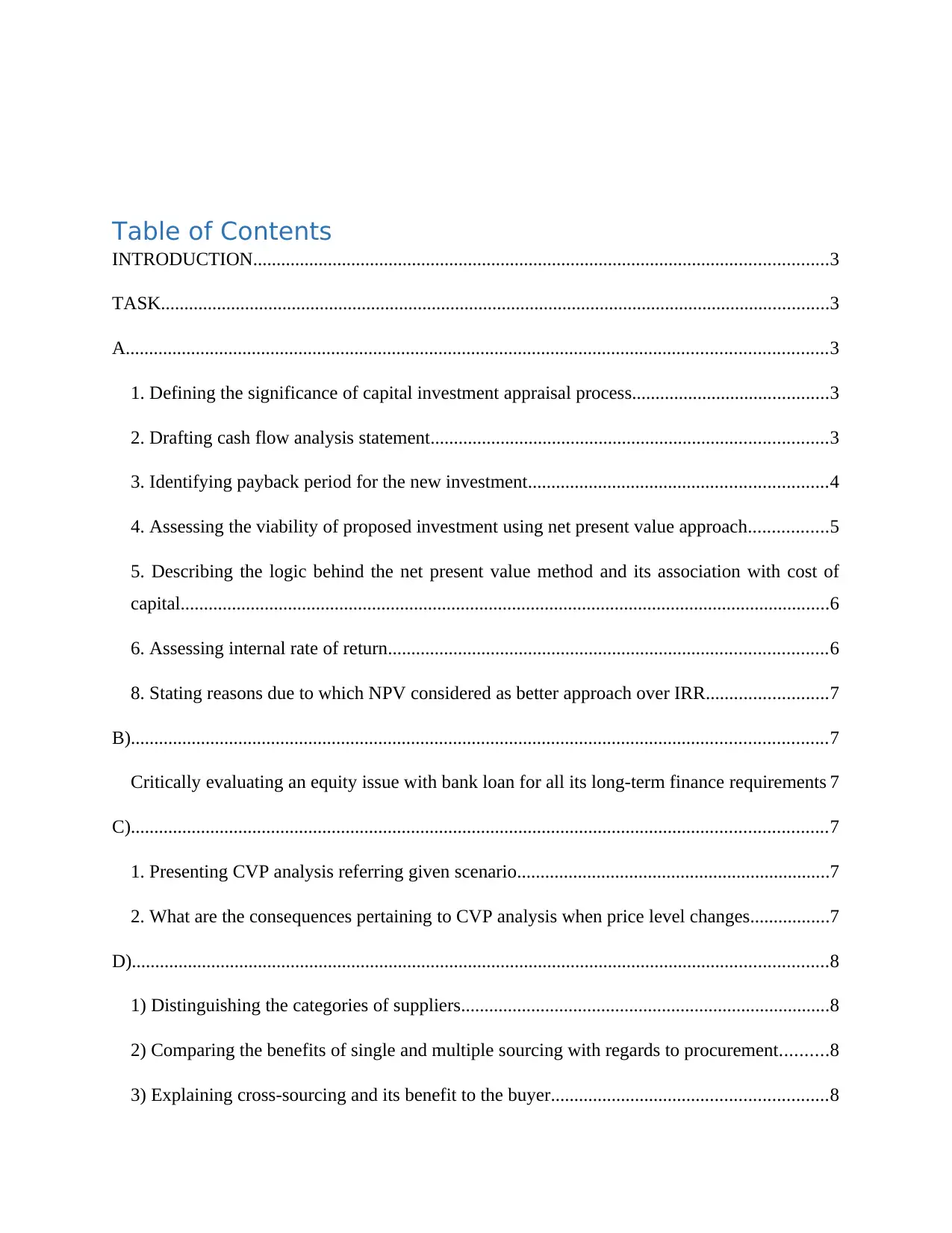
Table of Contents
INTRODUCTION...........................................................................................................................3
TASK...............................................................................................................................................3
A......................................................................................................................................................3
1. Defining the significance of capital investment appraisal process..........................................3
2. Drafting cash flow analysis statement.....................................................................................3
3. Identifying payback period for the new investment................................................................4
4. Assessing the viability of proposed investment using net present value approach.................5
5. Describing the logic behind the net present value method and its association with cost of
capital...........................................................................................................................................6
6. Assessing internal rate of return..............................................................................................6
8. Stating reasons due to which NPV considered as better approach over IRR..........................7
B).....................................................................................................................................................7
Critically evaluating an equity issue with bank loan for all its long-term finance requirements 7
C).....................................................................................................................................................7
1. Presenting CVP analysis referring given scenario...................................................................7
2. What are the consequences pertaining to CVP analysis when price level changes.................7
D).....................................................................................................................................................8
1) Distinguishing the categories of suppliers...............................................................................8
2) Comparing the benefits of single and multiple sourcing with regards to procurement..........8
3) Explaining cross-sourcing and its benefit to the buyer...........................................................8
INTRODUCTION...........................................................................................................................3
TASK...............................................................................................................................................3
A......................................................................................................................................................3
1. Defining the significance of capital investment appraisal process..........................................3
2. Drafting cash flow analysis statement.....................................................................................3
3. Identifying payback period for the new investment................................................................4
4. Assessing the viability of proposed investment using net present value approach.................5
5. Describing the logic behind the net present value method and its association with cost of
capital...........................................................................................................................................6
6. Assessing internal rate of return..............................................................................................6
8. Stating reasons due to which NPV considered as better approach over IRR..........................7
B).....................................................................................................................................................7
Critically evaluating an equity issue with bank loan for all its long-term finance requirements 7
C).....................................................................................................................................................7
1. Presenting CVP analysis referring given scenario...................................................................7
2. What are the consequences pertaining to CVP analysis when price level changes.................7
D).....................................................................................................................................................8
1) Distinguishing the categories of suppliers...............................................................................8
2) Comparing the benefits of single and multiple sourcing with regards to procurement..........8
3) Explaining cross-sourcing and its benefit to the buyer...........................................................8

CONCLUSION................................................................................................................................8
REFERENCES..............................................................................................................................10
REFERENCES..............................................................................................................................10
⊘ This is a preview!⊘
Do you want full access?
Subscribe today to unlock all pages.

Trusted by 1+ million students worldwide
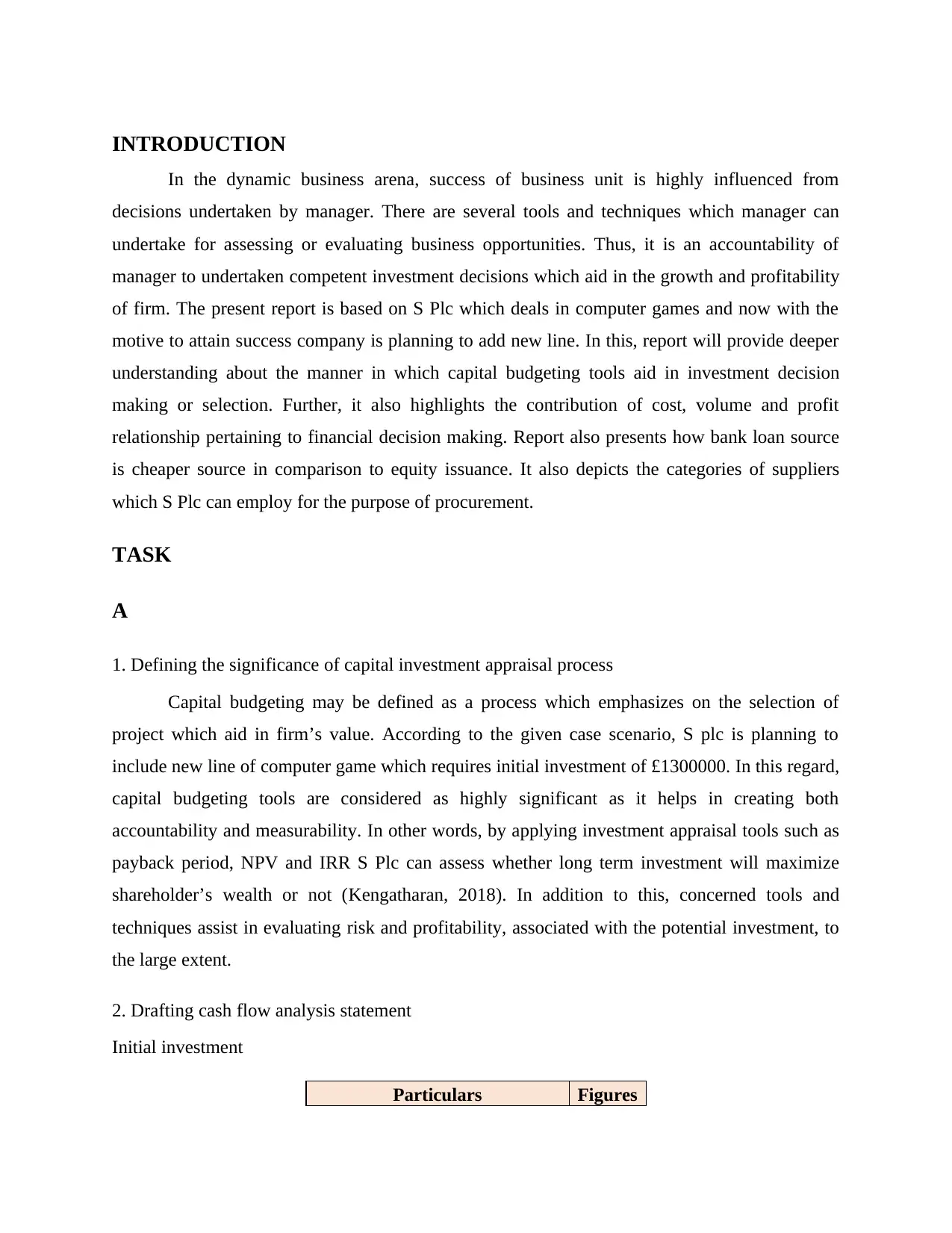
INTRODUCTION
In the dynamic business arena, success of business unit is highly influenced from
decisions undertaken by manager. There are several tools and techniques which manager can
undertake for assessing or evaluating business opportunities. Thus, it is an accountability of
manager to undertaken competent investment decisions which aid in the growth and profitability
of firm. The present report is based on S Plc which deals in computer games and now with the
motive to attain success company is planning to add new line. In this, report will provide deeper
understanding about the manner in which capital budgeting tools aid in investment decision
making or selection. Further, it also highlights the contribution of cost, volume and profit
relationship pertaining to financial decision making. Report also presents how bank loan source
is cheaper source in comparison to equity issuance. It also depicts the categories of suppliers
which S Plc can employ for the purpose of procurement.
TASK
A
1. Defining the significance of capital investment appraisal process
Capital budgeting may be defined as a process which emphasizes on the selection of
project which aid in firm’s value. According to the given case scenario, S plc is planning to
include new line of computer game which requires initial investment of £1300000. In this regard,
capital budgeting tools are considered as highly significant as it helps in creating both
accountability and measurability. In other words, by applying investment appraisal tools such as
payback period, NPV and IRR S Plc can assess whether long term investment will maximize
shareholder’s wealth or not (Kengatharan, 2018). In addition to this, concerned tools and
techniques assist in evaluating risk and profitability, associated with the potential investment, to
the large extent.
2. Drafting cash flow analysis statement
Initial investment
Particulars Figures
In the dynamic business arena, success of business unit is highly influenced from
decisions undertaken by manager. There are several tools and techniques which manager can
undertake for assessing or evaluating business opportunities. Thus, it is an accountability of
manager to undertaken competent investment decisions which aid in the growth and profitability
of firm. The present report is based on S Plc which deals in computer games and now with the
motive to attain success company is planning to add new line. In this, report will provide deeper
understanding about the manner in which capital budgeting tools aid in investment decision
making or selection. Further, it also highlights the contribution of cost, volume and profit
relationship pertaining to financial decision making. Report also presents how bank loan source
is cheaper source in comparison to equity issuance. It also depicts the categories of suppliers
which S Plc can employ for the purpose of procurement.
TASK
A
1. Defining the significance of capital investment appraisal process
Capital budgeting may be defined as a process which emphasizes on the selection of
project which aid in firm’s value. According to the given case scenario, S plc is planning to
include new line of computer game which requires initial investment of £1300000. In this regard,
capital budgeting tools are considered as highly significant as it helps in creating both
accountability and measurability. In other words, by applying investment appraisal tools such as
payback period, NPV and IRR S Plc can assess whether long term investment will maximize
shareholder’s wealth or not (Kengatharan, 2018). In addition to this, concerned tools and
techniques assist in evaluating risk and profitability, associated with the potential investment, to
the large extent.
2. Drafting cash flow analysis statement
Initial investment
Particulars Figures
Paraphrase This Document
Need a fresh take? Get an instant paraphrase of this document with our AI Paraphraser
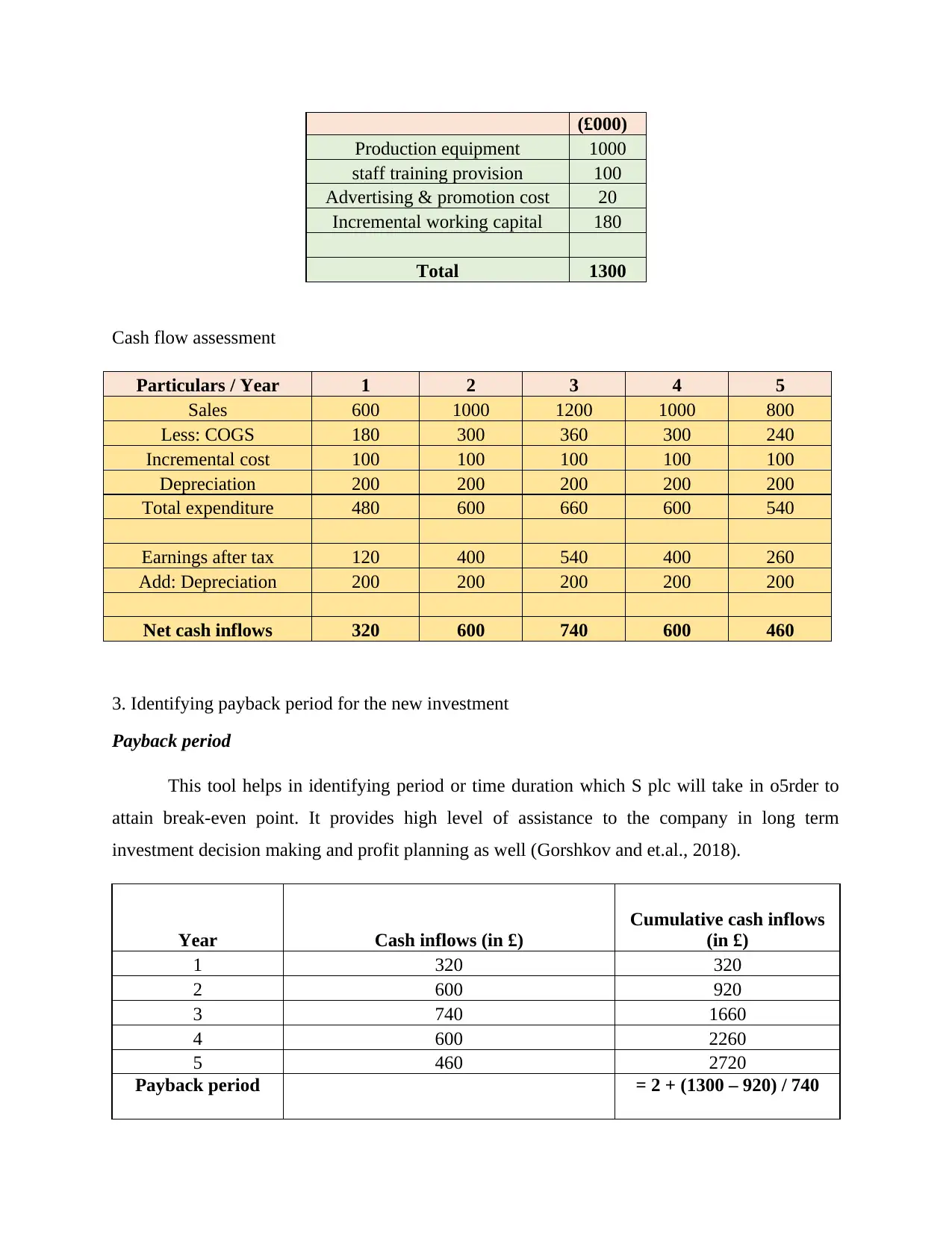
(£000)
Production equipment 1000
staff training provision 100
Advertising & promotion cost 20
Incremental working capital 180
Total 1300
Cash flow assessment
Particulars / Year 1 2 3 4 5
Sales 600 1000 1200 1000 800
Less: COGS 180 300 360 300 240
Incremental cost 100 100 100 100 100
Depreciation 200 200 200 200 200
Total expenditure 480 600 660 600 540
Earnings after tax 120 400 540 400 260
Add: Depreciation 200 200 200 200 200
Net cash inflows 320 600 740 600 460
3. Identifying payback period for the new investment
Payback period
This tool helps in identifying period or time duration which S plc will take in o5rder to
attain break-even point. It provides high level of assistance to the company in long term
investment decision making and profit planning as well (Gorshkov and et.al., 2018).
Year Cash inflows (in £)
Cumulative cash inflows
(in £)
1 320 320
2 600 920
3 740 1660
4 600 2260
5 460 2720
Payback period = 2 + (1300 – 920) / 740
Production equipment 1000
staff training provision 100
Advertising & promotion cost 20
Incremental working capital 180
Total 1300
Cash flow assessment
Particulars / Year 1 2 3 4 5
Sales 600 1000 1200 1000 800
Less: COGS 180 300 360 300 240
Incremental cost 100 100 100 100 100
Depreciation 200 200 200 200 200
Total expenditure 480 600 660 600 540
Earnings after tax 120 400 540 400 260
Add: Depreciation 200 200 200 200 200
Net cash inflows 320 600 740 600 460
3. Identifying payback period for the new investment
Payback period
This tool helps in identifying period or time duration which S plc will take in o5rder to
attain break-even point. It provides high level of assistance to the company in long term
investment decision making and profit planning as well (Gorshkov and et.al., 2018).
Year Cash inflows (in £)
Cumulative cash inflows
(in £)
1 320 320
2 600 920
3 740 1660
4 600 2260
5 460 2720
Payback period = 2 + (1300 – 920) / 740

= 2.5 years
The above depicted table shows that S Plc is required 2 years and 5 months for getting
back the amount of initial investment. As per the case scenario, company will give priority to the
investment having max 3 years’ payback period. In accordance with this criteria, concerned
investment opportunity will prove to be more fruitful for S plc. Moreover, in the proposed
project business organization will start to earn profit approx. 7 months earlier from the set
criteria. Hence, it can be stated that manager of S plc should access the proposal which will aid
in profit margin positively.
4. Assessing the viability of proposed investment using net present value approach
(Gaspars-Wieloch, 2019)
Year
Cash inflows (in
£)
Cost of capital
@20%
Present value of cash
inflows (in £)
1 320 0.833 267
2 600 0.694 417
3 740 0.579 428
4 600 0.482 289
5 460 0.402 185
Sum of PV inflows 1586
Less: II 1300
Net present value 286
By applying the concept of time value of money (20%), on the given cash flows, it has
identified that proposed investment will contribute in organizational success. In this, S Plc will
The above depicted table shows that S Plc is required 2 years and 5 months for getting
back the amount of initial investment. As per the case scenario, company will give priority to the
investment having max 3 years’ payback period. In accordance with this criteria, concerned
investment opportunity will prove to be more fruitful for S plc. Moreover, in the proposed
project business organization will start to earn profit approx. 7 months earlier from the set
criteria. Hence, it can be stated that manager of S plc should access the proposal which will aid
in profit margin positively.
4. Assessing the viability of proposed investment using net present value approach
(Gaspars-Wieloch, 2019)
Year
Cash inflows (in
£)
Cost of capital
@20%
Present value of cash
inflows (in £)
1 320 0.833 267
2 600 0.694 417
3 740 0.579 428
4 600 0.482 289
5 460 0.402 185
Sum of PV inflows 1586
Less: II 1300
Net present value 286
By applying the concept of time value of money (20%), on the given cash flows, it has
identified that proposed investment will contribute in organizational success. In this, S Plc will
⊘ This is a preview!⊘
Do you want full access?
Subscribe today to unlock all pages.

Trusted by 1+ million students worldwide

get £286000 after the period of five years. It shows that company is getting positive and higher
return in against to the initial investment made. As per overall evaluation company should go
with new line of computer game. This in turn helps it in getting the desired level of outcome or
success.
5. Describing the logic behind the net present value method and its association with cost of
capital
NPV method of investment appraisal represents difference which takes place between
present values of cash inflows and outflows. It provides high level of assistance to the manager
in taking appropriate decision about investment by analyzing profitability (Sarwary, 2020). NPV
and cost of capital is highly associated with each other. Moreover, cost capital (WACC) helps in
determining opportunity cost and thereby assists S Plc in selecting best alternative available for
investment purpose. NPV and WACC help company in assessing the whether concerned
opportunity prove to be beneficial or not (Bierman, 2020).
6. Assessing internal rate of return
Internal rate of return
This method is used by business unit for calculating the rate of return associated with the
concerned investment. IRR represents discounting rate where initial investment and present
value of cash flows become zero (Bierman, 2020). On the basis of this method, S Plc should
invest £1300000 in the new business opportunity. Moreover, concerned opportunity offers 29%
return which in turn considered as highly good for the organization.
Year Cash inflows
0 -1300
1 320
2 600
3 740
4 600
5 460
return in against to the initial investment made. As per overall evaluation company should go
with new line of computer game. This in turn helps it in getting the desired level of outcome or
success.
5. Describing the logic behind the net present value method and its association with cost of
capital
NPV method of investment appraisal represents difference which takes place between
present values of cash inflows and outflows. It provides high level of assistance to the manager
in taking appropriate decision about investment by analyzing profitability (Sarwary, 2020). NPV
and cost of capital is highly associated with each other. Moreover, cost capital (WACC) helps in
determining opportunity cost and thereby assists S Plc in selecting best alternative available for
investment purpose. NPV and WACC help company in assessing the whether concerned
opportunity prove to be beneficial or not (Bierman, 2020).
6. Assessing internal rate of return
Internal rate of return
This method is used by business unit for calculating the rate of return associated with the
concerned investment. IRR represents discounting rate where initial investment and present
value of cash flows become zero (Bierman, 2020). On the basis of this method, S Plc should
invest £1300000 in the new business opportunity. Moreover, concerned opportunity offers 29%
return which in turn considered as highly good for the organization.
Year Cash inflows
0 -1300
1 320
2 600
3 740
4 600
5 460
Paraphrase This Document
Need a fresh take? Get an instant paraphrase of this document with our AI Paraphraser
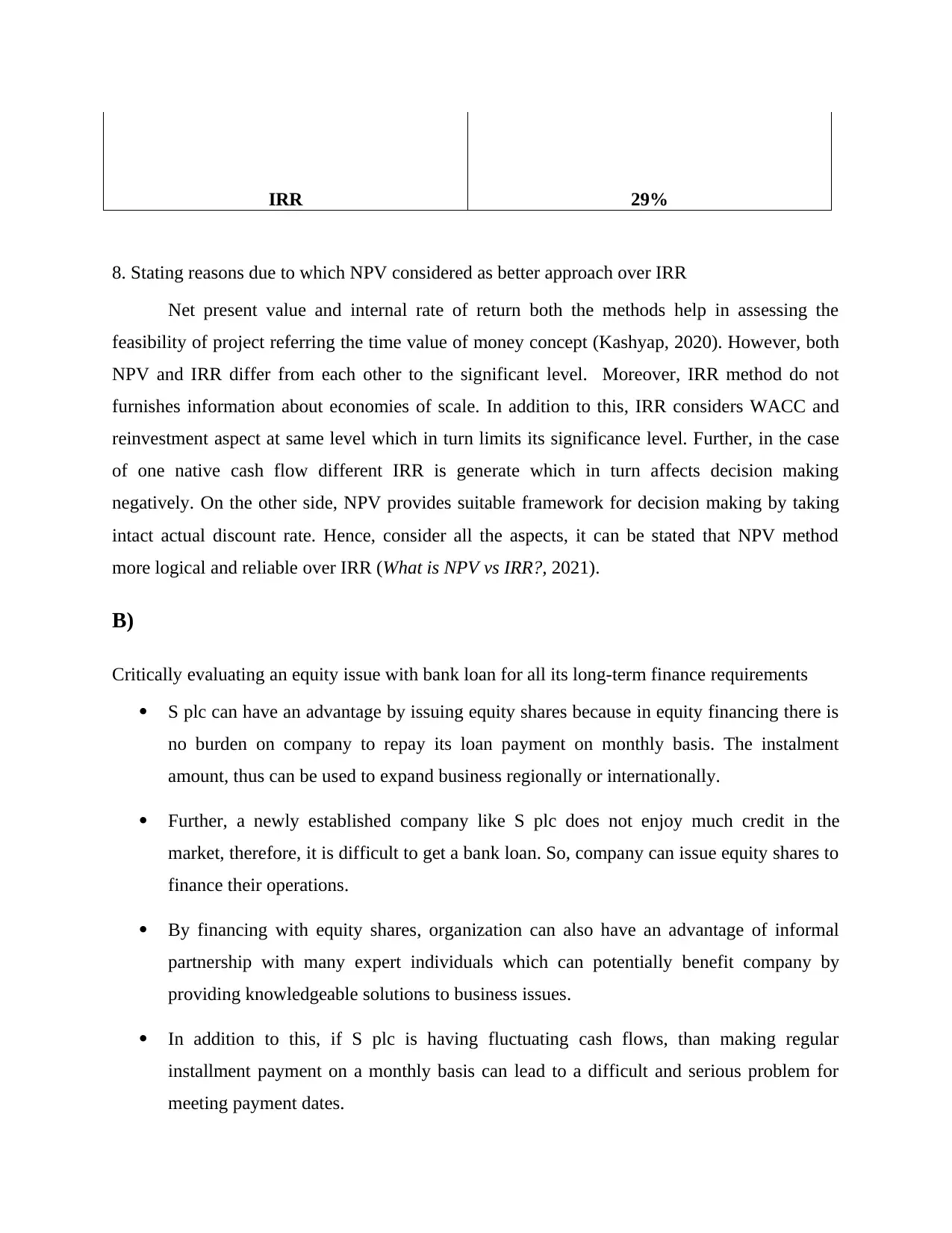
IRR 29%
8. Stating reasons due to which NPV considered as better approach over IRR
Net present value and internal rate of return both the methods help in assessing the
feasibility of project referring the time value of money concept (Kashyap, 2020). However, both
NPV and IRR differ from each other to the significant level. Moreover, IRR method do not
furnishes information about economies of scale. In addition to this, IRR considers WACC and
reinvestment aspect at same level which in turn limits its significance level. Further, in the case
of one native cash flow different IRR is generate which in turn affects decision making
negatively. On the other side, NPV provides suitable framework for decision making by taking
intact actual discount rate. Hence, consider all the aspects, it can be stated that NPV method
more logical and reliable over IRR (What is NPV vs IRR?, 2021).
B)
Critically evaluating an equity issue with bank loan for all its long-term finance requirements
S plc can have an advantage by issuing equity shares because in equity financing there is
no burden on company to repay its loan payment on monthly basis. The instalment
amount, thus can be used to expand business regionally or internationally.
Further, a newly established company like S plc does not enjoy much credit in the
market, therefore, it is difficult to get a bank loan. So, company can issue equity shares to
finance their operations.
By financing with equity shares, organization can also have an advantage of informal
partnership with many expert individuals which can potentially benefit company by
providing knowledgeable solutions to business issues.
In addition to this, if S plc is having fluctuating cash flows, than making regular
installment payment on a monthly basis can lead to a difficult and serious problem for
meeting payment dates.
8. Stating reasons due to which NPV considered as better approach over IRR
Net present value and internal rate of return both the methods help in assessing the
feasibility of project referring the time value of money concept (Kashyap, 2020). However, both
NPV and IRR differ from each other to the significant level. Moreover, IRR method do not
furnishes information about economies of scale. In addition to this, IRR considers WACC and
reinvestment aspect at same level which in turn limits its significance level. Further, in the case
of one native cash flow different IRR is generate which in turn affects decision making
negatively. On the other side, NPV provides suitable framework for decision making by taking
intact actual discount rate. Hence, consider all the aspects, it can be stated that NPV method
more logical and reliable over IRR (What is NPV vs IRR?, 2021).
B)
Critically evaluating an equity issue with bank loan for all its long-term finance requirements
S plc can have an advantage by issuing equity shares because in equity financing there is
no burden on company to repay its loan payment on monthly basis. The instalment
amount, thus can be used to expand business regionally or internationally.
Further, a newly established company like S plc does not enjoy much credit in the
market, therefore, it is difficult to get a bank loan. So, company can issue equity shares to
finance their operations.
By financing with equity shares, organization can also have an advantage of informal
partnership with many expert individuals which can potentially benefit company by
providing knowledgeable solutions to business issues.
In addition to this, if S plc is having fluctuating cash flows, than making regular
installment payment on a monthly basis can lead to a difficult and serious problem for
meeting payment dates.
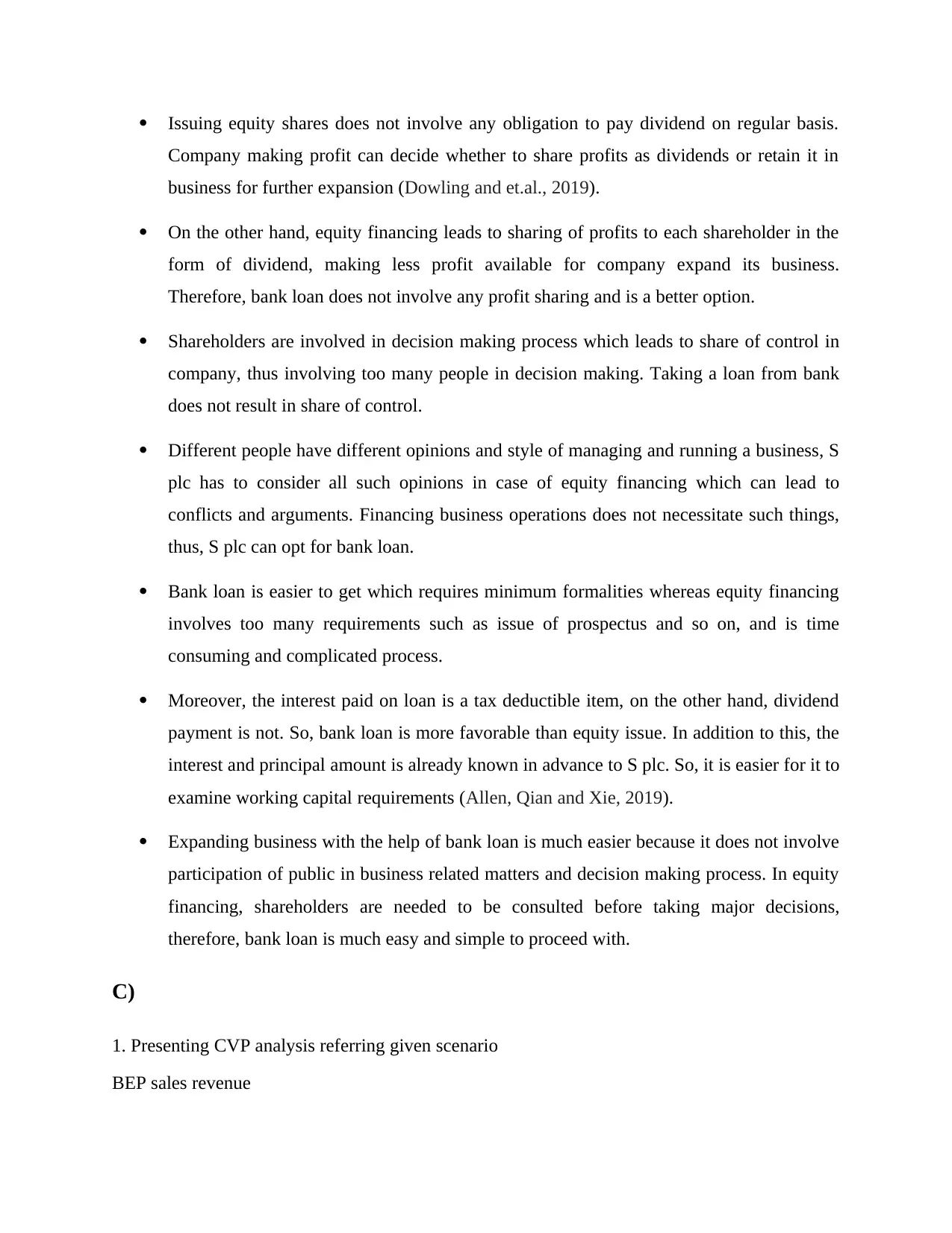
Issuing equity shares does not involve any obligation to pay dividend on regular basis.
Company making profit can decide whether to share profits as dividends or retain it in
business for further expansion (Dowling and et.al., 2019).
On the other hand, equity financing leads to sharing of profits to each shareholder in the
form of dividend, making less profit available for company expand its business.
Therefore, bank loan does not involve any profit sharing and is a better option.
Shareholders are involved in decision making process which leads to share of control in
company, thus involving too many people in decision making. Taking a loan from bank
does not result in share of control.
Different people have different opinions and style of managing and running a business, S
plc has to consider all such opinions in case of equity financing which can lead to
conflicts and arguments. Financing business operations does not necessitate such things,
thus, S plc can opt for bank loan.
Bank loan is easier to get which requires minimum formalities whereas equity financing
involves too many requirements such as issue of prospectus and so on, and is time
consuming and complicated process.
Moreover, the interest paid on loan is a tax deductible item, on the other hand, dividend
payment is not. So, bank loan is more favorable than equity issue. In addition to this, the
interest and principal amount is already known in advance to S plc. So, it is easier for it to
examine working capital requirements (Allen, Qian and Xie, 2019).
Expanding business with the help of bank loan is much easier because it does not involve
participation of public in business related matters and decision making process. In equity
financing, shareholders are needed to be consulted before taking major decisions,
therefore, bank loan is much easy and simple to proceed with.
C)
1. Presenting CVP analysis referring given scenario
BEP sales revenue
Company making profit can decide whether to share profits as dividends or retain it in
business for further expansion (Dowling and et.al., 2019).
On the other hand, equity financing leads to sharing of profits to each shareholder in the
form of dividend, making less profit available for company expand its business.
Therefore, bank loan does not involve any profit sharing and is a better option.
Shareholders are involved in decision making process which leads to share of control in
company, thus involving too many people in decision making. Taking a loan from bank
does not result in share of control.
Different people have different opinions and style of managing and running a business, S
plc has to consider all such opinions in case of equity financing which can lead to
conflicts and arguments. Financing business operations does not necessitate such things,
thus, S plc can opt for bank loan.
Bank loan is easier to get which requires minimum formalities whereas equity financing
involves too many requirements such as issue of prospectus and so on, and is time
consuming and complicated process.
Moreover, the interest paid on loan is a tax deductible item, on the other hand, dividend
payment is not. So, bank loan is more favorable than equity issue. In addition to this, the
interest and principal amount is already known in advance to S plc. So, it is easier for it to
examine working capital requirements (Allen, Qian and Xie, 2019).
Expanding business with the help of bank loan is much easier because it does not involve
participation of public in business related matters and decision making process. In equity
financing, shareholders are needed to be consulted before taking major decisions,
therefore, bank loan is much easy and simple to proceed with.
C)
1. Presenting CVP analysis referring given scenario
BEP sales revenue
⊘ This is a preview!⊘
Do you want full access?
Subscribe today to unlock all pages.

Trusted by 1+ million students worldwide
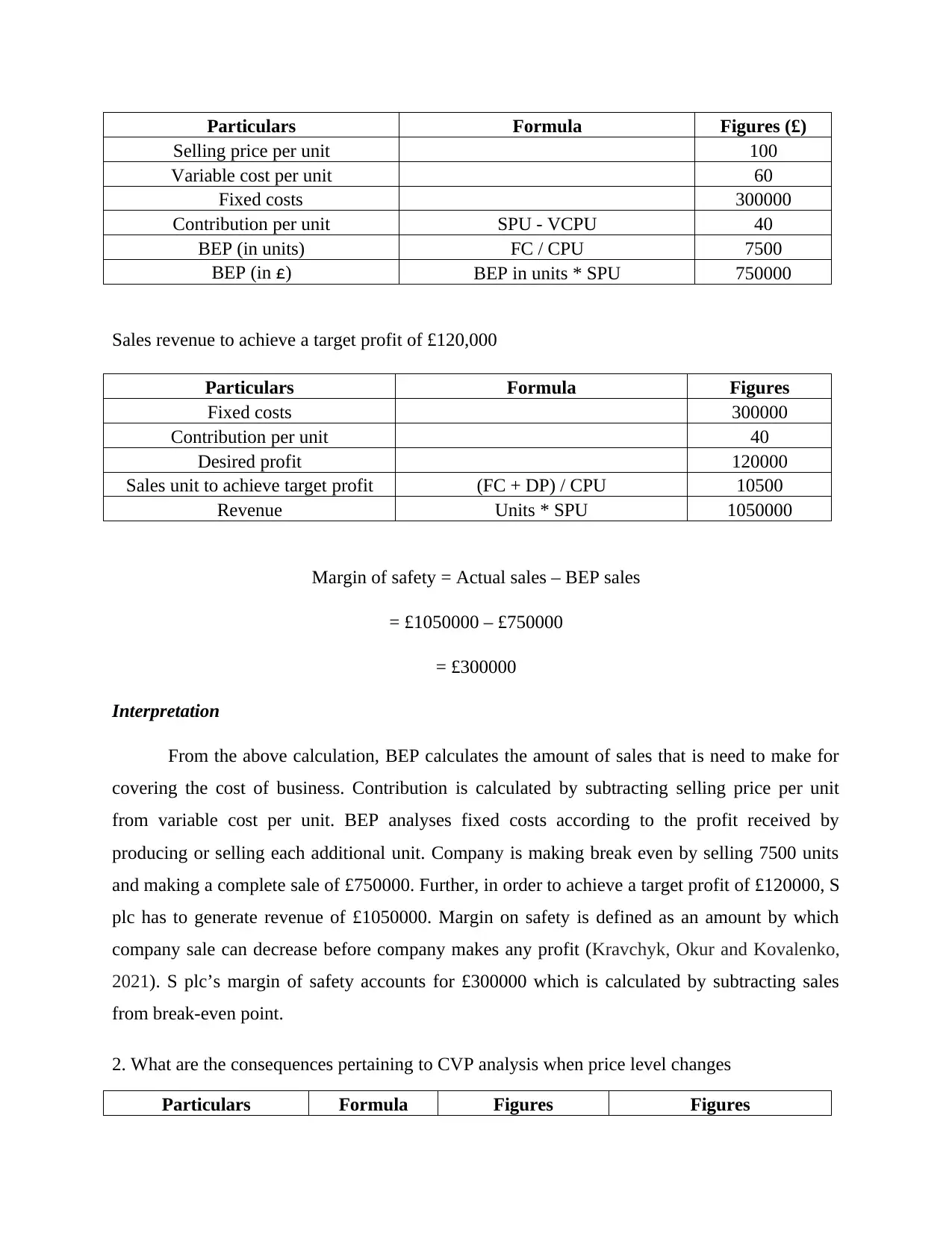
Particulars Formula Figures (£)
Selling price per unit 100
Variable cost per unit 60
Fixed costs 300000
Contribution per unit SPU - VCPU 40
BEP (in units) FC / CPU 7500
BEP (in £) BEP in units * SPU 750000
Sales revenue to achieve a target profit of £120,000
Particulars Formula Figures
Fixed costs 300000
Contribution per unit 40
Desired profit 120000
Sales unit to achieve target profit (FC + DP) / CPU 10500
Revenue Units * SPU 1050000
Margin of safety = Actual sales – BEP sales
= £1050000 – £750000
= £300000
Interpretation
From the above calculation, BEP calculates the amount of sales that is need to make for
covering the cost of business. Contribution is calculated by subtracting selling price per unit
from variable cost per unit. BEP analyses fixed costs according to the profit received by
producing or selling each additional unit. Company is making break even by selling 7500 units
and making a complete sale of £750000. Further, in order to achieve a target profit of £120000, S
plc has to generate revenue of £1050000. Margin on safety is defined as an amount by which
company sale can decrease before company makes any profit (Kravchyk, Okur and Kovalenko,
2021). S plc’s margin of safety accounts for £300000 which is calculated by subtracting sales
from break-even point.
2. What are the consequences pertaining to CVP analysis when price level changes
Particulars Formula Figures Figures
Selling price per unit 100
Variable cost per unit 60
Fixed costs 300000
Contribution per unit SPU - VCPU 40
BEP (in units) FC / CPU 7500
BEP (in £) BEP in units * SPU 750000
Sales revenue to achieve a target profit of £120,000
Particulars Formula Figures
Fixed costs 300000
Contribution per unit 40
Desired profit 120000
Sales unit to achieve target profit (FC + DP) / CPU 10500
Revenue Units * SPU 1050000
Margin of safety = Actual sales – BEP sales
= £1050000 – £750000
= £300000
Interpretation
From the above calculation, BEP calculates the amount of sales that is need to make for
covering the cost of business. Contribution is calculated by subtracting selling price per unit
from variable cost per unit. BEP analyses fixed costs according to the profit received by
producing or selling each additional unit. Company is making break even by selling 7500 units
and making a complete sale of £750000. Further, in order to achieve a target profit of £120000, S
plc has to generate revenue of £1050000. Margin on safety is defined as an amount by which
company sale can decrease before company makes any profit (Kravchyk, Okur and Kovalenko,
2021). S plc’s margin of safety accounts for £300000 which is calculated by subtracting sales
from break-even point.
2. What are the consequences pertaining to CVP analysis when price level changes
Particulars Formula Figures Figures
Paraphrase This Document
Need a fresh take? Get an instant paraphrase of this document with our AI Paraphraser
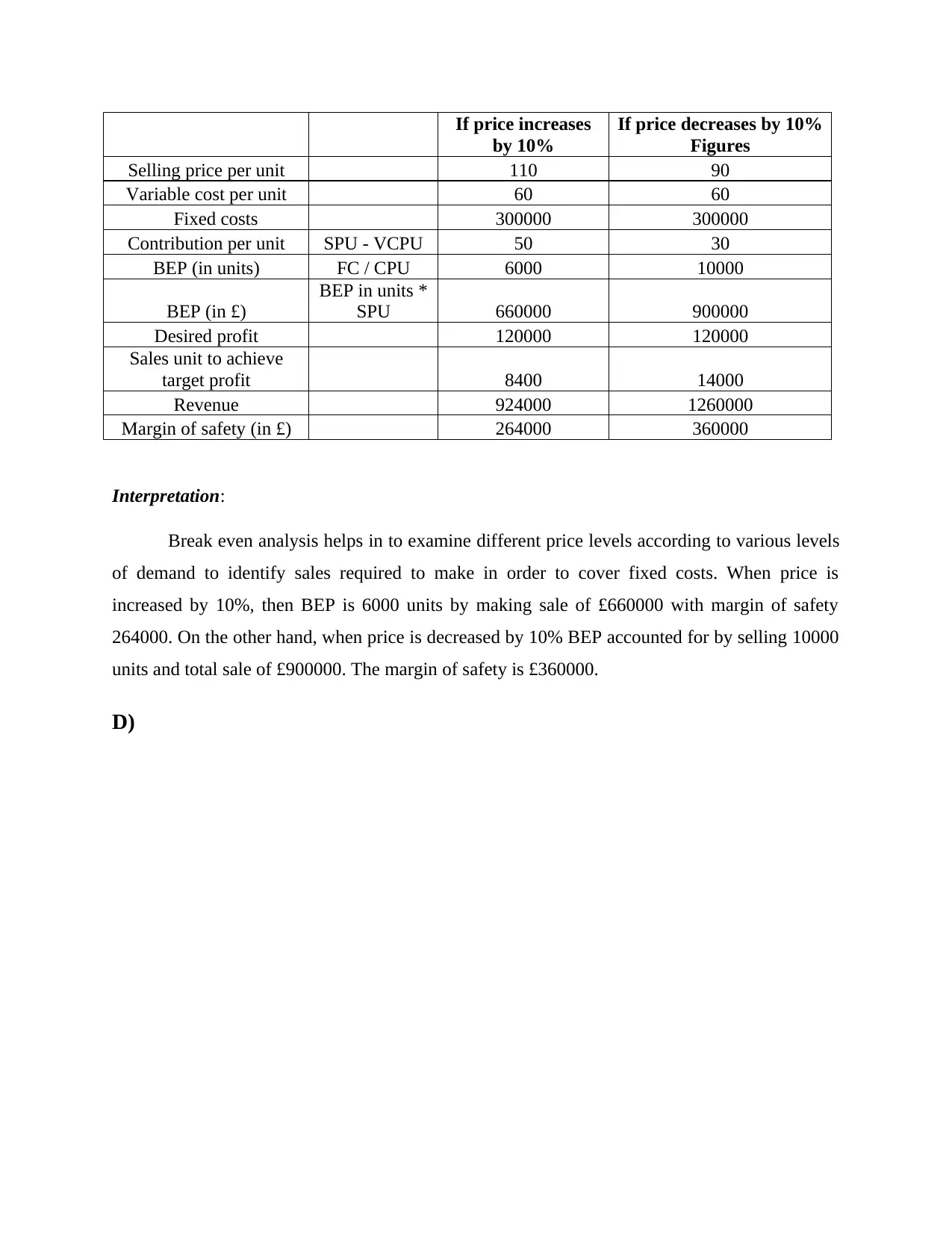
If price increases
by 10%
If price decreases by 10%
Figures
Selling price per unit 110 90
Variable cost per unit 60 60
Fixed costs 300000 300000
Contribution per unit SPU - VCPU 50 30
BEP (in units) FC / CPU 6000 10000
BEP (in £)
BEP in units *
SPU 660000 900000
Desired profit 120000 120000
Sales unit to achieve
target profit 8400 14000
Revenue 924000 1260000
Margin of safety (in £) 264000 360000
Interpretation:
Break even analysis helps in to examine different price levels according to various levels
of demand to identify sales required to make in order to cover fixed costs. When price is
increased by 10%, then BEP is 6000 units by making sale of £660000 with margin of safety
264000. On the other hand, when price is decreased by 10% BEP accounted for by selling 10000
units and total sale of £900000. The margin of safety is £360000.
D)
by 10%
If price decreases by 10%
Figures
Selling price per unit 110 90
Variable cost per unit 60 60
Fixed costs 300000 300000
Contribution per unit SPU - VCPU 50 30
BEP (in units) FC / CPU 6000 10000
BEP (in £)
BEP in units *
SPU 660000 900000
Desired profit 120000 120000
Sales unit to achieve
target profit 8400 14000
Revenue 924000 1260000
Margin of safety (in £) 264000 360000
Interpretation:
Break even analysis helps in to examine different price levels according to various levels
of demand to identify sales required to make in order to cover fixed costs. When price is
increased by 10%, then BEP is 6000 units by making sale of £660000 with margin of safety
264000. On the other hand, when price is decreased by 10% BEP accounted for by selling 10000
units and total sale of £900000. The margin of safety is £360000.
D)

1) Distinguishing the categories of suppliers
⊘ This is a preview!⊘
Do you want full access?
Subscribe today to unlock all pages.

Trusted by 1+ million students worldwide
1 out of 20
Related Documents
Your All-in-One AI-Powered Toolkit for Academic Success.
+13062052269
info@desklib.com
Available 24*7 on WhatsApp / Email
![[object Object]](/_next/static/media/star-bottom.7253800d.svg)
Unlock your academic potential
Copyright © 2020–2026 A2Z Services. All Rights Reserved. Developed and managed by ZUCOL.





